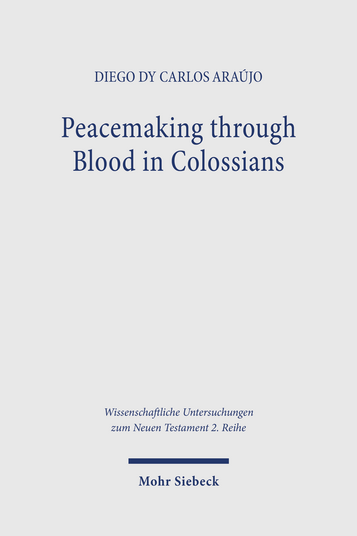Theology
Diego dy Carlos Araújo
Peacemaking through Blood in Colossians
An Analysis of the Imagery in Its Graeco-Roman and Jewish Context
[Friedensstiftung durch Blut im Kolosserbrief. Die griechisch-römischen und jüdischen Hintergründe des Konzepts und der Bildsprache.]
2023. Approx. 210 pages.
forthcoming in May
forthcoming in May
Wissenschaftliche Untersuchungen zum Neuen Testament 2. Reihe
84,00 €
including VAT
including VAT
sewn paper
ISBN 978-3-16-161873-4
forthcoming
Also Available As:
Published in English.
The imagery of »peacemaking through Christ's blood« in Colossians 1.20b evokes conceptual frames from both the Graeco-Roman and Jewish thought worlds. To grasp the full significance of the imagery, it is necessary to explore which frames could have been activated by the writer's metaphors. In this work, Diego dy Carlos Araújo applies insights from frame semantics and conceptual metaphor to investigate the multiple frames possibly evoked in the minds of the implied readers by the metaphorical expressions εἰρηνοποιήσας διὰ τοῦ αἵματος τοῦ σταυροῦ αὐτοῦ in this passage. Colossians' own version of the message challenges the cultural and theological expectations of the audience concerning peacemaking through bloodThe impact of its Christological configuration lies precisely in the incongruity between its message and the frames with which the hearers were familiar.Survey of contents
Chapter 1: Pax Romana as a Viable Graeco-Roman FrameA. Introduction: Parta victoriis pax
B. Pax Romana: A Brief Overview
C. Pax Romana in Asia Minor: The Availability of the Frame
D. Conclusion: Peace by Blood
Chapter 2: Pax Romana and Peacemaking Through Blood in Colossians
A. Introduction: Pax Romana and the Peace of Christ
B. Identifying the Frames
C. God's Triumph in Christ: Colossians 2.15
D. Christ's Peace and God's Triumph on the Cross – Colossians 1.20b and 2.15 in Context
E. The Transforming Power of the Metaphor
F. Conclusion: The Triumph of Christ's Peace
Chapter 3: Rîb-Controversy as a Viable Jewish Frame
A. Introduction: Reconciliation in the Jewish Conceptual World
B. Rîb-controversy in the Old Testament
C. The »Rîb-Pattern« as a Conceptual Frame
D. Conclusion: The Re-establishment of Peace
Chapter 4: Courtroom Controversy in Isaiah and Maccabees
A. Introduction: God's Servant's »Blood«
B. Deutero-Isaiah: Considerations on Method and Delimitations
C. Israel's Deliverance as Second Exodus in Deutero-Isaiah
D. Courtroom Controversy in the Book of Isaiah
E. Blood and Peace in The Maccabean Martyrology
F. Conclusion: Peace by the »Blood« of God's Servant
Chapter 5: Peacemaking Through Blood in Colossians 1.20b: Christ's Cosmic Peace
A. Introduction: Superior Blood, Superior Peace
B. The Thematic Structure of Colossians 1.12–23: A Brief Appraisal
C. Second Exodus Frame in Colossians 1.12–14
D. Deutero-Isaiah Frames in Colossians
E. The Maccabean Martyrology Frame in Colossians
F. The Transforming Power of the Metaphor
G. Conclusion: Peace at Last
